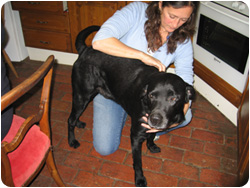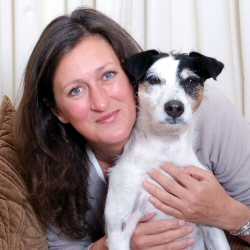Bowen Technique for Dogs
|
|
|
Co-sponsors of the 2023 Winning Out
Certificates |
The light touch therapy...
|
|
Canine Bowen Technique is a hands-on remedial therapy. It is different to many other complementary therapies as it involves a series of gentle rolling type moves made on different parts of the body. There are rest periods in between moves to allow the body to process the effects of each series of moves. The Bowen moves can promote healing, help to re-balance and re-align the body. It can offer pain relief for a variety of conditions, increase joint mobility, provide opportunity for relaxation and may help with energy levels. The Bowen Technique is a very effective therapy for people and horses as well but it's important that you choose a therapist who is specifically qualified for what they practice to ensure the best and safest treatment for your dog.
What types of condition can it help?
In addition it can enhance sports performance, aid recovery from surgery and illness, muscular strains & sprains, auto-immune disorders and can contribute to overall good health which may help to reduce the likelihood of injury or illness in all dogs and particularly working or competition dogs.
How many sessions will the dog need?
Is it safe?
|
Agility Dog Case Study Reuben, a small collie x Corgi agility dog came to me with intermittent lameness. He had been checked and referred by his vet who had not been able to make a clear diagnosis on why he was occasionally lame on getting up from sleeping. The lameness would wear off and sometimes come back again for short periods of time on a walk. He had been having a form of chiropractic treatment for some time, but he didn't like it and had to be muzzled to be handled or touched by the therapist and vet. When doing Bowen, I don't muzzle dogs and will only practice Bowen on a dog that is comfortable to be touched and am happy to take the time for them to become comfortable with me. The first time I met Reuben he was very suspicious, I assessed him and took video of him walking and turning then just went for a walk with him and his owner. Over a relatively short period of time he become more confident to be touched, actually pulling to come for treatment and his lameness disappeared. He has become happier at home, better at being groomed and touched by his owner and more relaxed and playful with the other dog he lives with. His performance in agility is wonderful, and he has been very successful moving up in grade. Reuben still comes to me for a Bowen 'top up' every couple of months and is a different dog from the suspicious and tense dog I first saw. There has been no reoccurrence of the lameness, and he appears in good health both physically and mentally. |
 What
will happen during the session?
What
will happen during the session?
Firstly, the Canine Bowen Technique therapist will take a full history of the dog and observe
the dog moving, sitting, standing and lying (where appropriate) and also note any medication
that the dog is on and what veterinary advice you have been given. The therapist may want
to know about the dog's life, daily routine, diet and exercise to help them to see the whole
picture.
Once a visual and physical observation has been done the therapist will proceed with the treatment taking care to ensure the dog's comfort at all times. The therapist will assess the dog between the moves and at the end of the session.
Some examples of types of problems that have been helped by Canine Bowen Technique include:-
4 year old cocker spaniel who had very low energy, intermittent lameness in all legs, difficulty walking, climbing stairs and getting up from a sit/down position. Veterinary tests had been inconclusive in diagnosing what was wrong. After one session the dog was able to get up from sit/down position unaided, had more energy and became a young dog again. After a second session the dog appeared to be normal and has continued to lead an active and happy life.
12 month old lurcher was nervous and exhibited destructive chewing behaviour after being spayed. After one session she was more relaxed and didn't chew anything that wasn't hers. She had a second session and became her normal confident and well adjusted self. She also healed very quickly.
8 year old Labrador bruised his back going under a gate on a day out shooting, his back was painful to touch and he appeared stiff and sore when he walked. He had one session and then slept. The next day he walked easily, was sound and didn't mind his back being touched.
How do I find a Canine Bowen Technique Therapist?
Either through the European Guild of Canine Bowen Therapists (www.caninebowentechnique.com)
or the Bowen Therapist' European Register (www.bter.org)
.
©Winkie Spiers - March 2008
 About
the author...
About
the author...
Winkie Spiers
(Cert E.C.B.S., Human Bowen
Therapist, Canine Bowen Therapist, Member Of PDTE, Member of APDT) lives in SW London with her
two dogs, Dennis, an ex-rescue Parsons Jack Russell and her lurcher, Maisie.
After many office bound years in the corporate world, she now works full-time as a dog trainer and behaviourist and is a practising Bowen Therapist for both people and dogs. In addition, Winkie plans and conducts talks and seminars on various dog related subjects both in the UK and Europe.
Her views and lifestyle are holistic and she consistently strives to update her skills and expand her professional knowledge in all areas. Her aim in life is to improve the general understanding and knowledge of dogs to the mutual benefit of both dogs and their owners. She seeks to dispel the myths and outdated ideas that can have a negative impact on our relationship with dogs. In all dog related matters she works actively with vets to ensure that she provides an informed and balanced view on dog related issues.
Winkie is the author of a hands-on, no nonsense, practical guide to living with your dog reviewed on Agilitynet
To find out more about Winkie and her puppy classes, Canine Bowen, her 1:1 training and much much more just go to www.winkiespiers.com
First published 21/07/09
|
[bottom.htm]
© Copyright Agilitynet
|